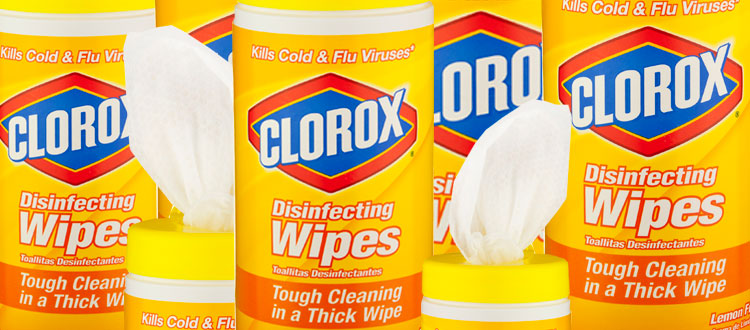Click here to DOWNLOAD this Fact Sheet.
Español – Productos de Limpieza y Su Salud
Cleaning is a regular and needed part of our lives. And certainly, there are some great physical and psychological benefits to keeping your surroundings clean. However, cleaning products can also pose some health risks. There are numerous chemicals found in cleaning products that are hazardous, and which can affect your health when you use them.[1]
When you use cleaning products, cleaning chemicals get into your body in these two main ways:
Inhalation: Breathing fumes into your lungs.
Absorption: Absorbing chemicals through your skin, especially your hands. When your hands are frequently wet, as happens with routine cleaning, the skin’s protective barrier can become damaged, making the skin even more vulnerable to absorbing chemicals from cleaning products.[2] You can also absorb some volatile chemicals directly through your skin from the air.[3]
Effects of cleaning product exposure
Acute effects of cleaning product exposure: (Acute effects are short-term symptoms and conditions that often occur immediately or very soon after product use.)
Eye injury: Eye injuries are commonly reported to poison centers, especially from accidents using cleaners in spray bottles containing corrosive ingredients such as chlorine bleach.[4]
Childhood poisonings: Accidental swallowing or spilling of cleaning products sends thousands of small children to the hospital each year, and has resulted in several deaths.[6]
Skin irritation and rashes: Cleaning products are common causes of rashes and other skin problems.[5]
Breathing problems: Use of some cleaning products has been known to lead to shortness of breath, and exacerbation of asthma and other lung diseases.[7]
Chronic effects of cleaning product exposure: (Chronic effects are long-lasting conditions and diseases developed over a longer period of time. Generally, chronic effects have been studied in cleaning workers, but are rarely if ever researched with respect to household cleaning.)
Lung cancer: Women who clean for a living have been shown to have twice the risk of getting lung cancer, compared to women in other professions.[8]
Allergic contact dermatitis: Cleaning workers have higher rates of skin conditions such as allergic contact dermatitis associated with the cleaning products they use.[10]
Asthma: Studies of cleaning workers have found increased rates of adult onset asthma and work-aggravated asthma compared to people in other professions.[9]
Cleaning Chemicals of Greatest Concern:
What to watch out for and avoid
Antimicrobial chemicals: Triclosan, Triclocarban, quaternary ammonium compounds such as benzalkonium chloride (ADBAC), Didecyldimethylammonium chloride (DDAC) and others.
Antimicrobial chemicals are inherently toxic as they are designed to kill living microbes. While they effectively kill germs on surfaces, there is no evidence that killing germs (particularly in a household setting) is actually effective at keeping your family any healthier.[13] Overuse (and unnecessary use) of antimicrobial chemicals can also lead to the development of stronger drug-resistant bacteria in our environment.[14]
Acutely corrosive/irritating chemicals: Oven cleaner and drain cleaner chemicals (sodium hydroxide), Ammonia (ammonium hydroxide) and chlorine bleach (sodium hypochlorite).
Products containing these chemicals often contain label language stating “Danger” or “Warning” due to their potential for causing serious skin burns and permanent eye damage. Inhalation of fumes from products containing these chemicals can also lead to respiratory irritation and breathing problems. Commonly, product labels include recommendations to use gloves, eye protection, and occasionally breathing masks to use these products in your home.
Solvents linked to reproductive effects: Glycol ethers (2-butoxyethanol, ethylene glycol monomethyl ether (EGME), and others)
Women who clean for a living have higher exposures to glycol ethers from cleaning products. Studies have found higher rates of birth defects in the children of cleaning workers with occupational exposures to glycol ethers.[15][16][17]
Fragrance chemicals: Thousands of synthetic chemicals are used to create modern day fragrances for our products[18], and some of these chemicals have been linked to health impacts ranging from eye and skin irritation, headaches, breathing problems[19] to hormone imbalance[20] and increased risk of breast cancer.[21] Identifying the most problematic fragrance chemicals is extremely difficult, as fragrance ingredients are rarely disclosed by manufacturers.
Recommendations for Safer Use of Cleaning Products
- Look for fragrance-free cleaning products – or products which disclose the ingredients in their fragrances.
- Use antibacterial cleaners sparingly – employ them only for particular situations with high chance of spreading infections.
- Wash your hands thoroughly throughout the day and before eating to prevent the spread of disease instead of disinfecting surfaces.
- Read the labels – pay special attention to products that use the word “Danger” or “Caution” – read instructions carefully on these products. Use protective eyewear and gloves if recommended. Wash your hands thoroughly after use.
- Do not use or store dangerous cleaners in households where children or pets are present. This includes bleach sprays, oven cleaners, drain cleaners, single load laundry pods.
- Make your own cleaners from safer ingredients: Get our simple recipes at www.womensvoices.org.
Published Oct. 2017
Click here to DOWNLOAD this Fact Sheet.
Español – Productos de Limpieza y Su Salud
[1] Steinemann, A (2015) Volatile emissions from common consumer products. Air Quality, Atmosphere & Health. Vol. 8, No. 3, pp.273-281. June 2015.
[2] Behroozy, A and Keegel TG. (2014) Wet-work exposure: A Main Risk Factor for Occupational Hand Dermatitis. Safety and Health at Work. Vol. 5, No. 4, pp: 175-180. December 2014.
[3] Weschler CJ and Nazaroff WW. (2012) SVOC Exposure Indoors: Fresh Look at Dermal Pathways. Indoor Air. Vol. 22, pp: 356-377. 2012.
[4] McKenzie, L.B., Ahir, N., Stolz, U. and Nelson, N.G. (2010) Household Cleaning Product-Related Injuries Treated in US Emergency Departments in 1990-2006. Pediatrics. Vol. 126, No. 3, pp: 509-516. September 2010.
[5] Bauer A. (2013) Contact Dermatitis in the Cleaning Industry. Current Opinion in Allergy and Clinical Immunology. Vol. 13, No. 5, pp: 521-524. October 2013.
[6] Mowry JB, Spyker DA. Brooks DE, Zimmerman A and Schauben JL. (2016) 2015 Annual Report of the American Association of Poison Control Centers’ National Poison Data System (NPDS): 33rd Annual Report, Clinical Toxicology, Vol. 54, No. 10, 924-1109. 2016.
[7] Zock JP (2005) World at Work: Cleaners. Occupational and Environmental Medicine. Vol. 62, No. 8, pp:581-584. August 2005.
[8] Atramont A, Guida F, Mattei F, Matrat M, Cenee S, Sanchez M, Carton M, Menvielle G, Marrer E, Neri M, Luce D, Stucker I and the ICARE study group. (2016) Professional Cleaning Activities and Lung Cancer Risk Among Women: Results from the ICARE Study.
[9] Siracusa, A, De Blay F, Folletti I, Moscato G, Olivieri M, Quirce S, Raulf-Heimsoth M, Sastre J, Tarlo SM, Walusiak-Skorupa J and Zock JP. (2013) Asthma and exposure to cleaning products – a European Academy of Allergy and Clinical Immunology task force consensus statement. European Journal of Allergy and Clinical Immunology. Vol. 68, pp: 1532-1545. 2013.
[10] Liskowsky, J, Geier, J. and Bauer, A. (2011) Contact allergy in the cleaning industry: analysis of contact allergy surveillance data of the Information Network of Departments of Dermatology. Contact Dermatis. Vol. 65. pp: 159-166. 2011.
[11] Chevrier C., Dananche B., Bahuau M., Nelva A., Herman C., Francannet C., Robert-Gnansia E. and Cordier S. (2006) Occupational exposure to organic solvent mixtures during pregnancy and the risk of non-syndromic oral clefts. Occupational and Environmental Medicine. Vol. 63, pp:617-623. 2006.
[12] Olshan, AF., Baird, PA., Teschke, K. (1989) Paternal Occupational Exposures and the Risk of Down Syndrome. American Journal of Human Genetics. Vol. 44: 646-651. 1989. http://www.ncbi.nlm.nih.gov/pubmed/2523192
[13] Halden RU, Lindeman AE, Aiello AE, Andrews D, Arnold WA, Fair P, Fuoco RE, Geer LA, Johnson PI, Lohmann R, McNeill K,Sacks VP, Schettler T, Weber W, Zoeller RT and Blum A. (2017) The Florence Statement on Triclosan and Triclocarban. Environmental Health Perspectives. Vol. 125, No. 6. June 2017.
[14] Aiello A et.al. (2003) Antibacterial cleaning and hygiene products as an emerging risk factor for antibiotic resistance in the community. Lancet. Vol.3: 501-506. August 2003.
[15] Chevrier C., Dananche B., Bahuau M., Nelva A., Herman C., Francannet C., Robert-Gnansia E. and Cordier S. (2006) Occupational exposure to organic solvent mixtures during pregnancy and the risk of non-syndromic oral clefts. Occupational and Environmental Medicine. Vol. 63, pp:617-623. 2006.
[16] Herdt-Losavio et.al. (2010) Maternal occupation and the risk of birth defects: an overview from the National Birth Defects Prevention Study. Occup. Envir. Med. Vol. 67, pp. 58-66. http://www.ncbi.nlm.nih.gov/pubmed/20029025
[17] Lorente C., Cordier S., Bergeret A., De Walle HEK., Goujard J., Ayme S., Knill-Jones R., Calzolari E. and Bianchi F. (2000) Maternal Occupational Risk Factors for Oral Clefts. Scandinavian Journal of Work, Environment and Health. Vol. 26, No.2, pp:137-145. 2000.
[18] International Fragrance Association (IFRA) (2013) IFRA Survey: Transparency List. Available at: http://www.ifraorg.org/en-us/ingredients
[19] Kumar, P., Caradonna-Graham, V.M., Gupta, S, Cai, X, Rao, P.N. and Thompson, J. (1995) Inhalation challenge effects of perfume scent strips in patients with asthma. Annals of Allergy, Asthma and Immunology. Vol. 75, pp: 429-433. November 1995.
[20] Women’s Voices for the Earth (2015) Fragrance Chemicals on the European Union Endocrine Disruptors Priority List. https://womensvoices.org/fragrance-ingredients/fragrance-chemicals-endocrine-disruptors-priority-list/
[21] Rudel RA, Ackerman JM, Attfield KR and Brody JG. (2014) New Exposure Biomarkers as Tools for Breast Cancer Epidemiology, Biomonitoring, and Prevention: A Systematic Approach Based on Animal Evidence. Environmental Health Perspectives. Vol. 122, No. 9, pp: 881-895. September 2014.





